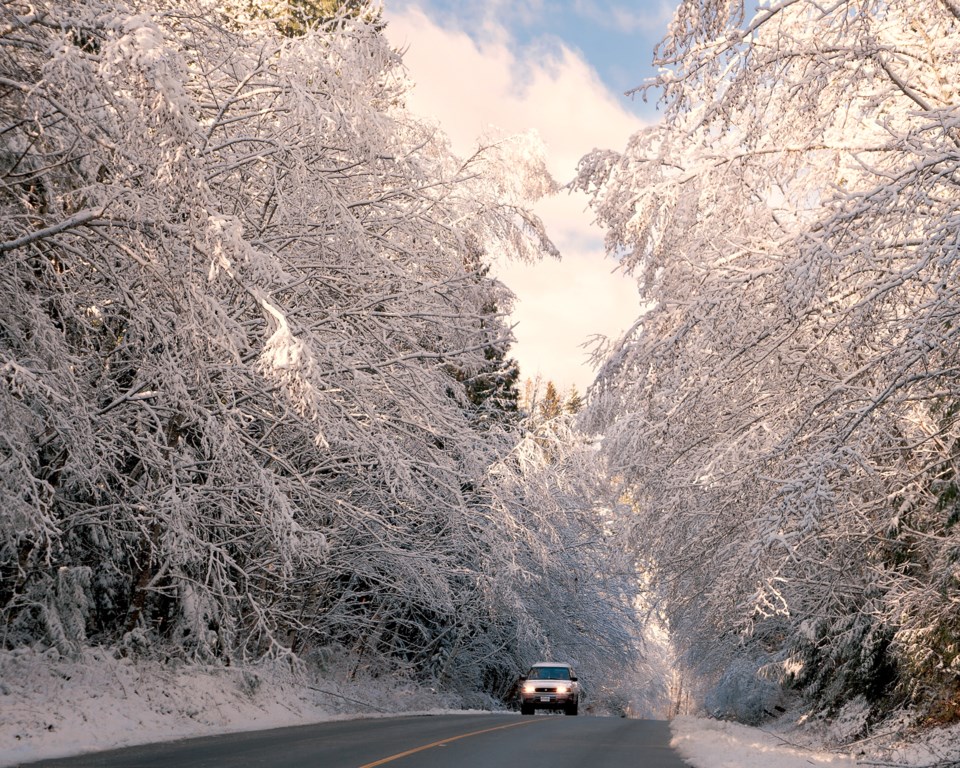A winter storm came late this season, bringing with it record-breaking freezing temperatures, snowfall and power outages across the Sunshine Coast.
Snow began blanketing the Coast Saturday evening and continued into Sunday morning. On Feb. 17, Sechelt broke the record for greatest snowfall amount for that day, receiving 6.8 cm, beating the 6 cm record set in 1989. Snow accumulation averaged 3 cm across the Coast, with some areas such as Port Mellon receiving 5 cm, said Cindy Yu, Environment Canada meteorologist.
Ted Olynyk from BC Hydro reported 5,000 customers in the Sechelt area lost power at the peak of the storm, with all customers restored by Sunday evening. Outside crews from Squamish and other areas helped bring customers back online. Gambier Island residents lost power due to a broken utility pole. Equipment was brought in by barge, and residents were fully restored by Monday.
After the snow came the cold. Sechelt and Gibsons both broke deep-freeze records. On Feb. 19, Sechelt experienced an unprecedented overnight low of -7.5 for that day, while Gibsons broke its 1990 -5 C record with a -6 C freeze. Yu said another system is expected Friday that might bring more snow, or rain if it warms up.
The Sechelt shelter remained full over the weekend, as it has been since late December, said Aaron Munro, associate director at RainCity Housing. “We definitely take extra care during cold snaps and try to encourage people to come indoors.” He said the Gibsons shelter, which opened earlier this month has additional capacity. “We are actually in a pretty good position.”
Munro said the outreach worker on the Coast has been looking out for people, especially in secluded areas. “People being isolated in cold mountains is not a good idea,” he said.
John Williams, bylaw officer at Gibsons, said residential, commercial and industrial properties for the most part have been in compliance with the bylaw requiring them to clear snow from sidewalks fronting their properties.
“We’ve had a few that we’ve had to contact, but for the most part the residents and businesses are very responsible,” Williams said.
Gibsons crews initiated salting of the streets last week before the storm hit to reduce ice formation, and snowplows were removing snow from 11:30 p.m. Saturday until 8:30 a.m. Sunday. Salting the streets cost $2,500 and plowing cost $4,200.
Sechelt residents also followed a similar snow-clearing bylaw, said Julie Rogers, communications manager at the District of Sechelt. “People had shovelled their sidewalks right away and we had no issues there.”
Crews put brine on the roads before the storm to keep snow from sticking. Snow clearing began at 1 a.m. Sunday morning, and by 2 p.m., 127 km of road had been cleared by four plow trucks. One crew was also called in to clear trees from the roads, which had fallen under the weight of the snow.
RCMP reported no major incidents on the roads.
“It was actually not bad,” said Sgt. Mike Hacker. He said the late start to the snow and early morning cleanup kept conditions safe during hours with more traffic.
The Sechelt Landfill remained closed until 2:30 p.m. on Sunday because of winter conditions.



